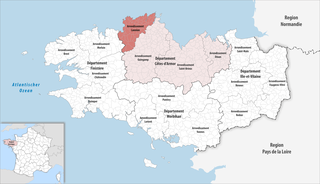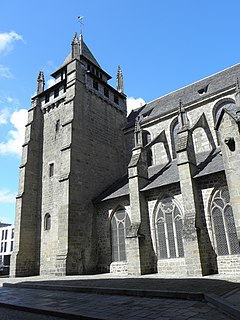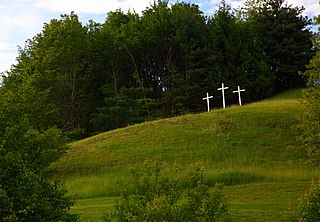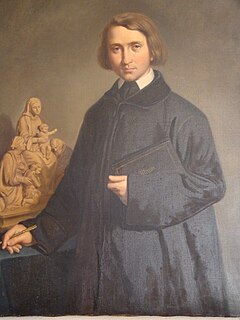
Yves Hernot is the name of two sculptors, father and son, who ran the Ateliers Yves Hernot sculpture workshop in Lannion, Brittany, which specialised in creating Calvaries and tombs.

Yves Hernot is the name of two sculptors, father and son, who ran the Ateliers Yves Hernot sculpture workshop in Lannion, Brittany, which specialised in creating Calvaries and tombs.
Yves Hernot senior (1829 - 1890) established himself in Lannion in 1844. The son of a stonemason, he was given the opportunity to study art, but preferred to work on traditional monumental masonry. However, he won the Grand Prix de Rome for Sculpture, and showed his works at the 1867 World Fair. His work was generally associated with the church. A devout Catholic and conservative Royalist, during his lifetime 517 Calvaries were created by his workshop. He also created several tombs, including that of the last bishop of Treguier, whose body was returned to Brittany half a century after he had died in exile after the Revolution.
Hernot also wrote many songs in the Breton language, which he printed and distributed. One contrasts a Catholic and an atheist, another warns against the presence of Protestants. Others express anti-republican views, such as Ar gaouiad Republik (The Deceptive Republic). These political songs were often signed "Ur c'hoz masouner" (An old mason). [1]
Yves Hernot junior (1861 - 1929) inherited his father's business after the latter's death in 1890. By this time the workshop employed over 80 workers. Under Yves junior the company created 440 more Calvaries, of which the most important were the Calvary of Protest in Tréguier and the Breton Calvary in Lourdes.
The Breton Calvary was created in 1900 as a gift to Lourdes from the main Breton dioceses: Rennes, Vannes, Quimper and Saint-Brieuc. [2] [3] The monument comprises a single central cross set within a raised square base at each corner of which a statue of one of the witnesses to the crucifixion is placed.

The Calvary of Protest (1904) was Yves junior's most ambitious work. It was intended as a "symbol of the ultramontane church triumphing over the 19th century", as a response to the recent monument to the religious sceptic Ernest Renan, created nearby, and the proposed law separating church and state instituted by the radicals of the Third Republic. [4] The monument includes the inscribed phrase "Truly this man was the Son of God" in the Latin, French and Breton languages below the main scene of lamenting figures at the foot of the cross. Beneath is a relief depicting Saint Yves between a rich and poor man, along with statues of Saint Tugdual, founder of Tréguier, and Saint Brieuc, after whom the chief town in the region is named. It is surrounded by statues of saints representing "spiritual combat": Saint Maurice, Saint George, Joan of Arc and Saint Louis. [4] They are flanked by Saint Peter and Saint Andrew.
Hernot also created freestanding secular works, notably his statue of French naval hero Abraham Duquesne in Concarneau.
After World War I the business created a large number of war memorials, including those of Lannion and Plestin-les-Grèves, both carved by Yves junior's son Léon Hernot (1894-1971). The latter was inaugurated in December 1923. [5]
Léon took over after his father's death, but the business ceased trading in 1932.
| Wikimedia Commons has media related to Yves Hernot . |

Tréguier is a port town in the Côtes-d'Armor department in Brittany in northwestern France. It is the capital of the province of Trégor.

The arrondissement of Lannion is an arrondissement of France in the Côtes-d'Armor department in the Brittany region. It has 57 communes. Its population is 99,903 (2016), and its area is 904.4 km2 (349.2 sq mi).
The following is a list of the 27 cantons of the Côtes-d'Armor department, in France, following the French canton reorganisation which came into effect in March 2015:

Saint-Brieuc Cathedral is a Roman Catholic church located in the town of Saint-Brieuc, Brittany, France, and dedicated to Saint Stephen.

Tréguier Cathedral is a Roman Catholic church and former cathedral in Tréguier, Côtes-d'Armor, France. It is dedicated to Saint Tudwal. The church was formerly the seat of the Bishopric of Tréguier, abolished under the Concordat of 1801, when its territories were divided between the Diocese of Quimper and the Diocese of Saint-Brieuc, known since 1852 as Saint-Brieuc-Tréguier.

Jean Boucher was a French sculptor based in Brittany. He is best known for his public memorial sculptures which communicated his liberal politics and patriotic dedication to France and Brittany.

Trévou-Tréguignec is a commune in the Côtes-d'Armor department of Brittany in northwestern France.

The Chemin de fer des Côtes-du-Nord, the Côtes-d'Armor today, was a 1,000 mm, metre gauge, railway in Côtes-du-Nord, France, although there were a few kilometres of line in Finistère and Ille-et-Vilaine. The first lines opened in 1905 and final closure was in 1956. The lines were a voie ferrée d'intérêt local system with a total extent of 457 kilometres (284 mi).

A calvary is a type of monumental public Christian cross, sometimes encased in an open shrine. Wayside crosses with or more commonly without sculpture can also be found in Devon e.g. the Dartmoor Crosses and Cornwall and in other parts of Britain referred to as High Crosses. Usually a calvary has three crosses, that of Jesus Christ and those of impenitent thief and penitent thief.
James Bouillé was a French architect based in Brittany.

Francis Renaud (1887–1973), was a Breton sculptor mainly noted for his monumental granite public memorials in Brittany.
Roland Doré was a 17th-century sculptor and his workshop or "atelier" produced many sculptures for the enclos paroissiaux or "parish church enclosure or closes" of Brittany. In particular his work can be seen on calvaries and in the church's south porch. He was born in 1616 and died in 1660. Little detail of his life is known but it is recorded that he practised as an architect in Landerneau, as well as running his workshop, and was recorded as calling himself the "Sculpteur du Roi". His works, all of an ecclesiastical nature, are mainly located in Léon and the north of Cornouaille. They can be taken as works by Doré's workshop rather than just by Doré himself. Brittany is particularly rich in calvaries, some of a very elaborate nature. In most cases the calvary involves both the crucifixion cross and side crosses or gibbets bearing the good and the bad robbers. Below this, on the crosspieces, were statues of those present at the crucifixion. A feature of Breton calvaries is that most of the statues were carved as a pair and effectively back to back. Doré's output was prodigious and he worked on nine monuments in Saint-Thégonnec, five in Logonna-Daoulas and four in the parish of Plougastel-Daoulas. He also received four commissions to work in Hanvec, three in Guiclan, Irvillac and Lampaul-Guimiliau and two commissions in Cléden-Cap-Sizun, Hôpital-Camfrout, Landerneau, La Martyre, Plabennec, Pleyben, Plogonnec, Saint-Nic, Saint-Servais and Saint-Urbain.

The Calvary at Kergrist-Moëlou in the Arrondissement of Guingamp in Brittany, France, dates back to 1578. It was the work of the sculptor Guillaume Jézéquel except for the crucifix which was the work of the sculptor Yves Hernot de Lannion and was remounted on the calvary in 1896. Kergrist-Moëlou is located in the Côtes-d'Armor region, the ancient diocese of Cornouaille. Jézéquel had worked alongside his brother on the Kergrist-Moëlou church in 1554. Originally the calvary's sculpture was substantial, with records showing that it was decorated with almost one hundred statues telling the story of the life and death of Jesus Christ, but sadly the calvary was vandalized during the 1793 French Revolution leaving many statues broken and decapitated with others disappearing completely. What is now left of the calvary stands on a large octagonal granite base and fragments of the mutilated figures are placed around the cross itself. This article gives some of the history of the calvary and describes its constituent parts.

The Saint-Michel cemetery' in Saint-Brieuc is located in the Rue Jobert de Lamballe.

Jean-Marie Valentin, was born at Bourg-des-Comptes in Ille-et-Vilaine on 17 October 1823 and died in Paris on 8 August 1896. He was an architect and a sculptor specialising in religious furnishings such as pulpits, altars and statues. His father Antoine Louis Valentin was a master carpenter working mostly in ebony. He was born in 1784. Jean-Marie first worked at his father's workshop.

Saint Efflamm is a semi-legendary penitent who was born in Britain and who died in Brittany. His feast is 6 November.
Communauté d'agglomération Lannion-Trégor Communauté is an intercommunal structure, centred on the city of Lannion. It is located in the Côtes-d'Armor department, in the Brittany region, western France. It was created in January 2017. Its seat is in Lannion. Its area is 904.4 km2. Its population was 99,607 in 2017, of which 19,880 in Lannion proper.